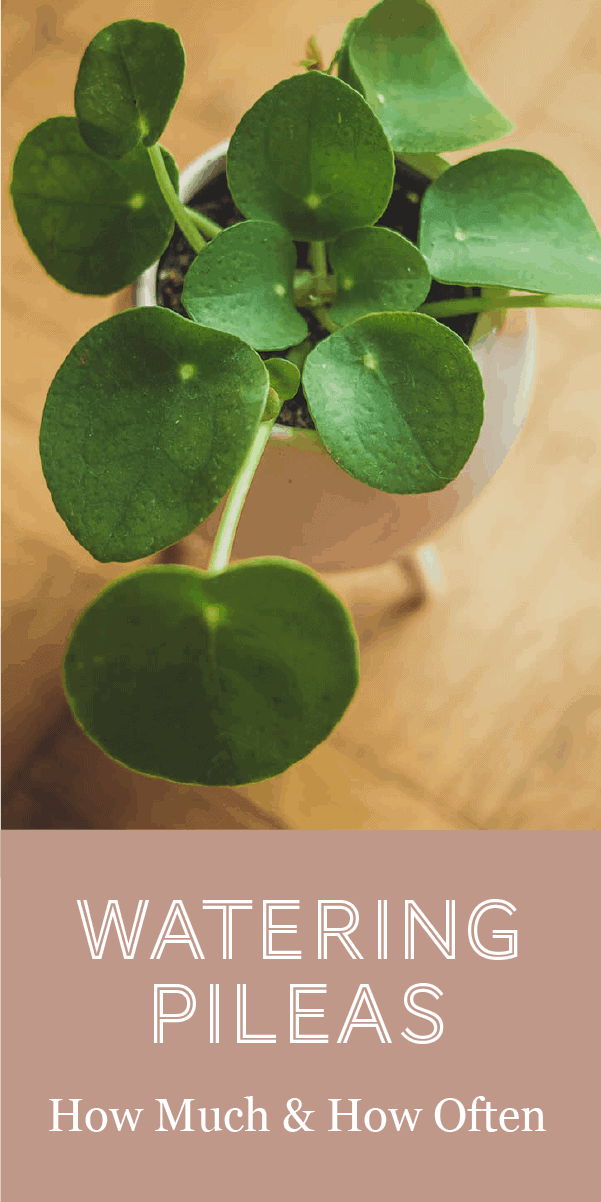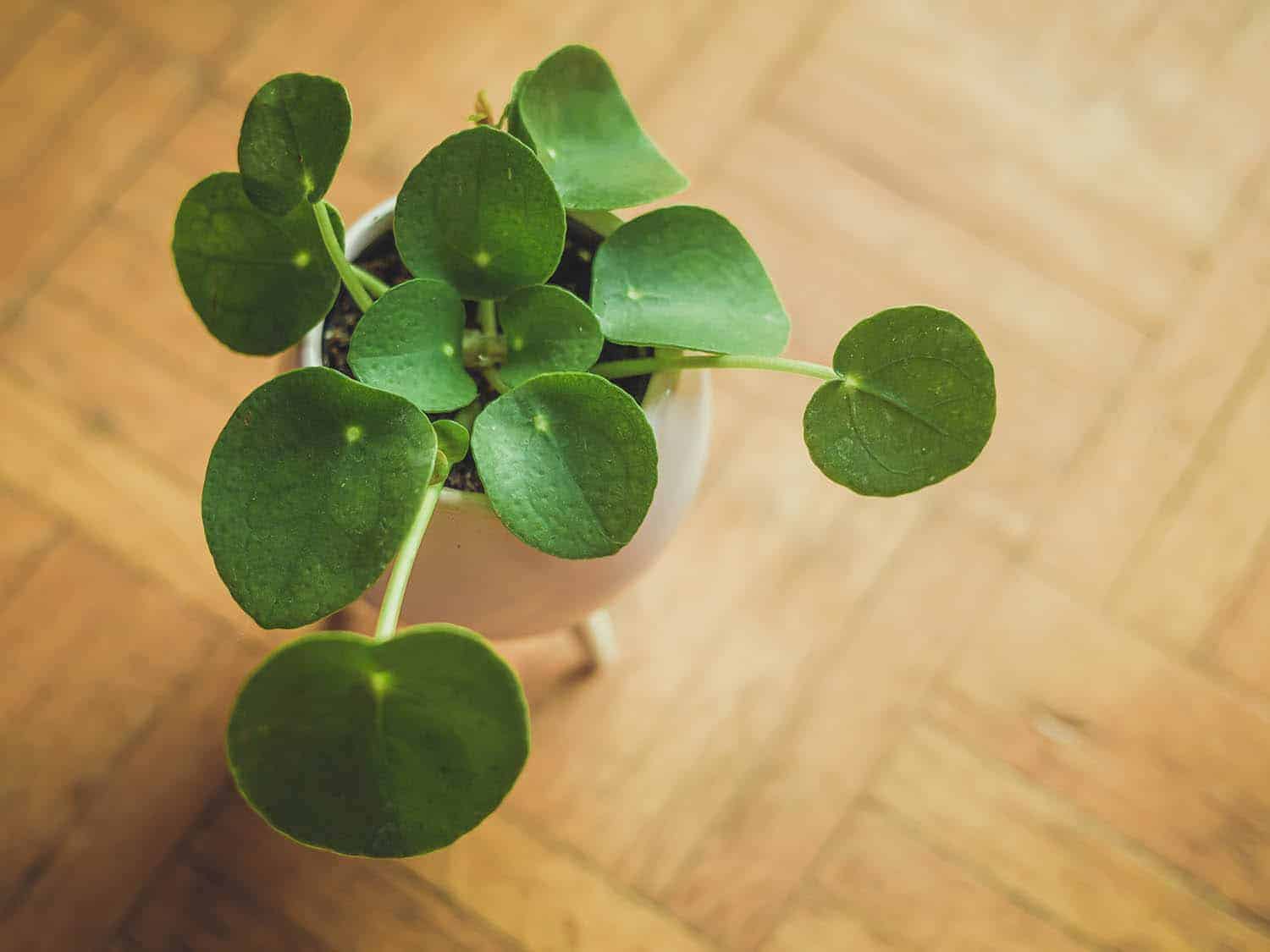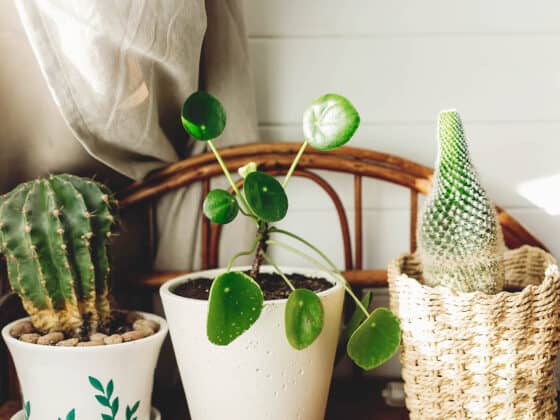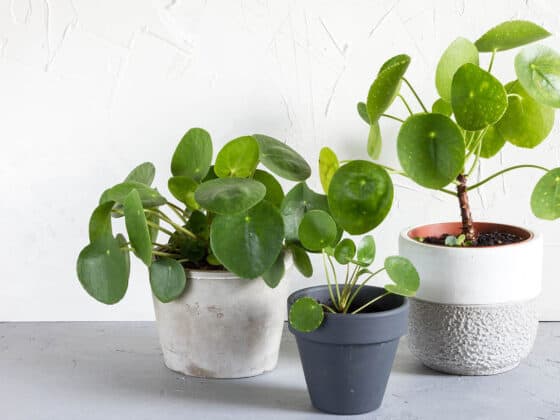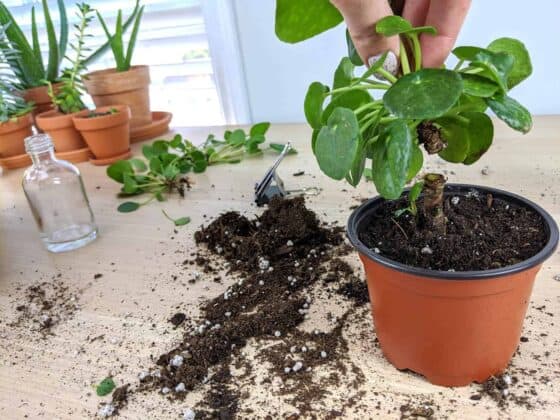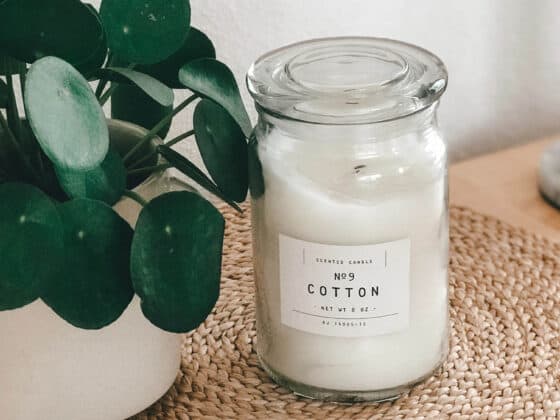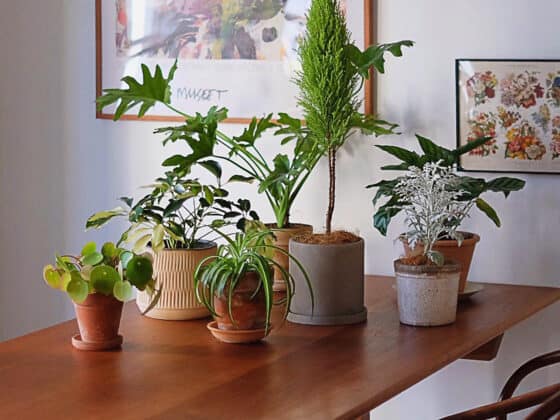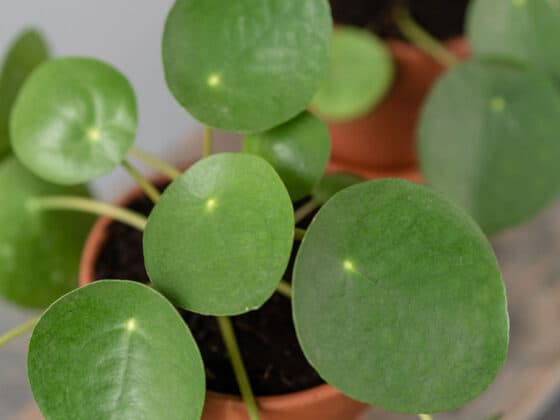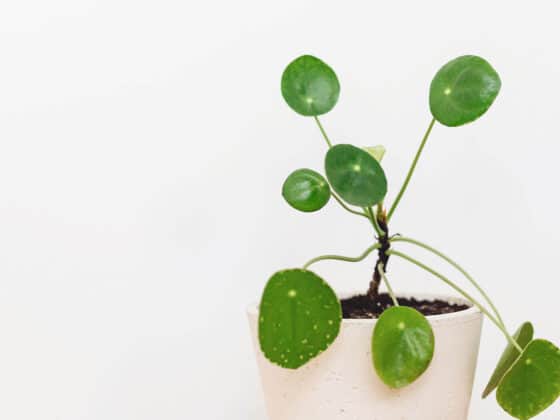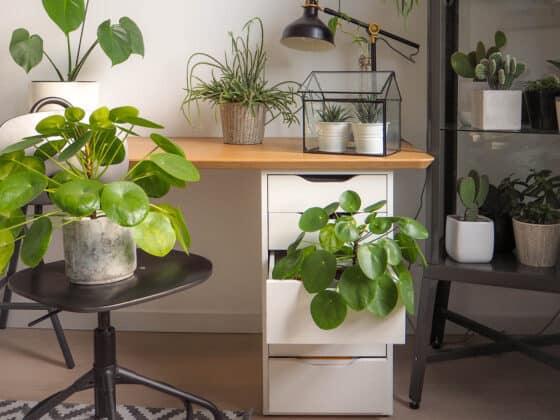Pilea Peperomioides, also known as Chinese Money Plants, have become extremely trendy over the last few years. Luckily, not only are they beautiful and unique, they are also very simple to keep. One of the only issues that people have in keeping Pileas alive is giving them too much water.
How much should you water Pileas? Pileas are technically succulents and therefore they prefer to only be watered when the top inch of soil is completely dry. When watering, be sure to water thoroughly so that water flows through all the soil and out the drainage hole in the bottom of your container.
Ninety percent of the problems facing Pileas, whether its pale leaves, spotting, or drooping are all a product of overwatering. So how can you remedy the problem before it arises? What steps can you take to keep from killing your Pilea with too much water? And what should you do if you think you’ve overwatered your plant? For all that and more, read on as I give you the complete guide for watering your Pileas.
The Quickest Way To Kill Your Pilea
Pileas are members of the Urticacea family and are technically perennial, evergreen succulents. While they are different from many other species in the succulent family, they do have one thing in common with most, they hate to be overly wet.
The number one quickest way to kill a Pilea Peperomioides is by keeping it too wet. Overly wet roots cause all sorts of problems for Pileas, from not allowing oxygen and nutrients to be absorbed to discolored, limp leaves and root rot. While these plants are extremely hardy, overwatering your plant will almost always send it to its grave.
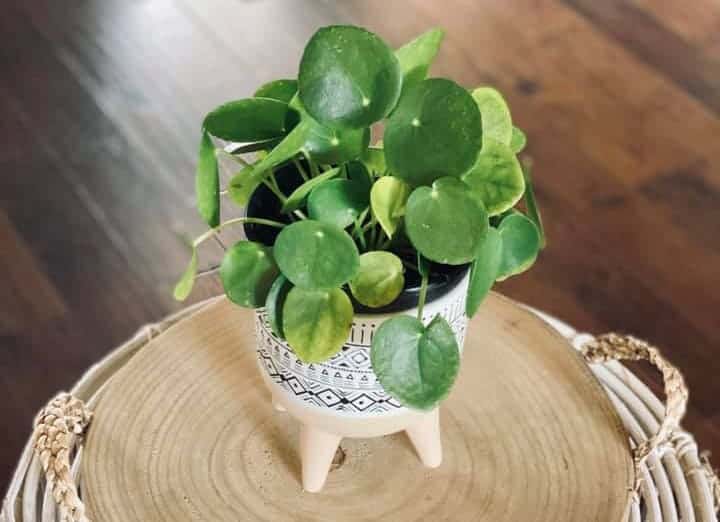
Overwatering can actually occur in several different ways. The first and most obvious is that you provided too much water too frequently to your plant. However, overwatering can also be a result of poor drainage, which usually has to do with the container it is planted in or the soil you’ve used to plant the Pilea.
Pilea containers need to meet two requirements: they must have a drainage hole in the bottom and they must be the proper size. Containers without a drainage hole or containers that are too large for the plant both extend the amount of time it takes the soil to dry out between watering. Pileas hate to sit in soggy soil and need to be planted properly to thrive.
Pileas should be planted in quick-draining soil to aid in drying the soil out completely and in a timely manner between waterings. I personally use succulent potting soil blends, but I know others who like to mix up something of their own. For more information on the best soil for your Pilea read this article.
Pilea Soil Needs to Dry Out Between Waterings
Some people like to water their houseplants on a schedule, like every Friday, but in my opinion, it’s best to take your cues from the soil itself. Relying on a schedule may lead to overwatering or even underwatering. Instead of checking your calendar, check the status of your soil every few days to determine when it’s time to water.
The best time to water your Pilea is when the top one inch of soil is completely dry. I usually check that my plants are ready to water by sticking my finger in the top inch of soil. If the soil is completely dry to the touch, I water the plant.
When you are in doubt, it is always best to wait a few extra days before watering. Too little water is better for a Pilea than too much.
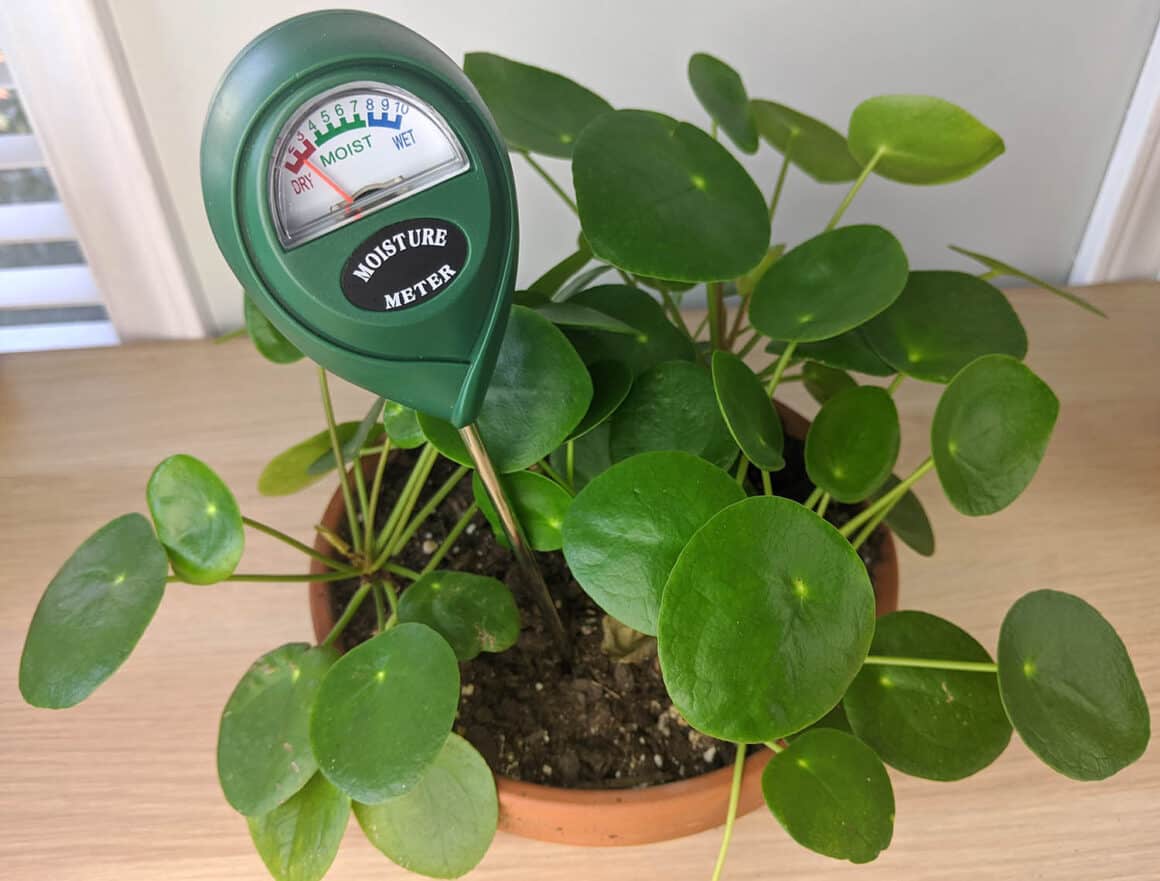
If you want to be more scientific with your watering, you can always purchase a soil moisture meter. This apparatus will give you a more accurate depiction of the level of moisture in your soil and can give you more exact information about when it is time to water. Personally, I don’t use them, but I know that lots of people want more exact data than I do.
Water Deeply, Instead of Lightly and Frequently
There are two basic methods for watering houseplants. The first is to water with a small amount of water frequently. The second is to water deeply with a large amount of water less often. The second option is almost always better for your houseplants.
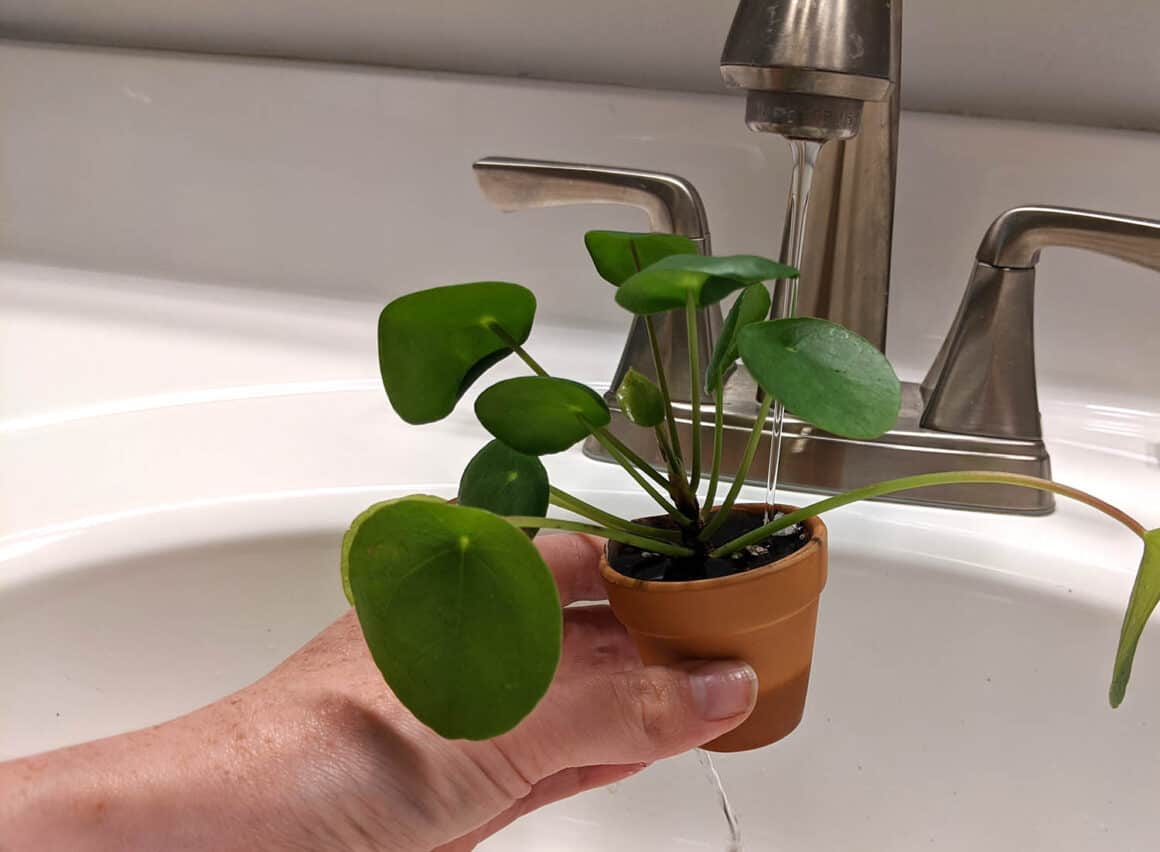
Your Pilea should be planted in a container with a hole in the bottom to assist with drainage. If you do not have your Pilea planted in a container like this, beware. Standing water is not a friend to Pileas. If I were you, I would move my Pilea to a proper container immediately, rather than risk overwatering it.
Once your plant is in the proper pot, you should water it thoroughly, until about 20% of the water you put in runs out through the drainage hole in the bottom. This ensures that the water has penetrated all of the soil and has been able to reach the roots system of your Pilea.
Signs You’ve Given Your Pilea Too Much Water
With nearly any change in a Pileas health, the first thing to investigate is the amount of water that has been provided to it and the frequency with which it has been done. Overwatering can appear in many different ways, these are just the five most common symptoms of overwatering.
(You should know that if you are certain you are not overwatering your plant, each of these symptoms can also point to other issues with your plant. For more information on diagnosing a sick Pilea, click here to read an article I wrote on the subject)
Pale Green or Yellow Leaves
The most common and often the first sign of overwatering is that the leaves of your Pilea will start to lose their deep, dark green color. When Pileas are overwatered, their foliage becomes pale, starting with a light green and eventually changing to yellow.
Droopy Leaves or Losing Leaves
It is normal for the older leaves on your plant, specifically those at the bottom of the stalk, to droop and eventually fall off. This is a result of senescence and it happens as Pileas age. However, if most of your leaves are drooping, even the ones at the top of the plant, it is most likely that you have an overwatering problem.
Brown or Yellow Spot
Leaves that have become spotted with brown or yellow spots are often a sign of overwatering. At a certain point, an overwatered Pilea’s roots can no longer absorb the oxygen and water they need, and, as a result, they cannot send the proper nutrients to the top portion of the plant. Brown or yellow spots are usually a result of this.
Leaves Curling
Curled leaves are most commonly caused by overwatering. Again, remember that while overwatering is sometimes the result of too much water too frequently, it can also be caused by improper drainage in your container and soil. If your leaves are curling, you should investigate your container along with your watering habits.
Smelly Soil or Mold Around the Base of Your Plant
Soil that has been allowed to be too wet for too long can feed fungus that has been lying dormant in the soil. Fungus is the cause of lots of problems and stinky, musty smelling soil is often one of the first signs. If you’ve noticed an odor from your soil or you can visibly see mold around the base of your Pilea, you have an overwatering problem.
If you have a Pilea that you suspect is suffering from overwatering based on these symptoms, click here to read an article I wrote with step by step instructions for saving an overwatered Pilea.
How To Know When It’s Time to Water Your Pilea
The best sign that it is time to water your Pilea is found in the soil. Just like I said before, I always check the top inch of my soil before watering. Be sure to stick your finger down into the soil to test that more than just the top layer is dry. When I can’t feel any moisture in the top inch, that is when I know it is time to water my Pilea.
Also, droopy leaves can be a sign that it is time to water your Pilea. If your leaves are constantly droopy, it is more likely that you’re overwatering. But if you have tested the top inch of soil and it is dry, and then you’ve waited another day or two to be sure, when leaves droop at that point, they are a sign that it is time to water your Pilea.
Watering During Growing Season vs. Dormancy
Pileas will need different amounts of water with different frequencies depending on the time of year you’re in. Plants absorb more water when they are in the growing season than when they are dormant.
All plants have a growing season. In nature, that is the time of year where the temperature and rainfall are ideal and allow a plant to grow successfully. When we pull plants into our homes, we expose them to consistent temperatures and watering, but we do not negate the growing season. This is the time of year when they will need the most water to support their growth.
During the colder months of the year, your houseplant may be more likely to suffer from overwatering. This is because plants become dormant during the winter months. Similar to bears who hibernate in winter, plants do a bit of shutting down themselves. During dormancy, plants are not actively growing and therefore don’t need as much water to survive.
If you are monitoring the moisture in your soil before you water, this will be evident to you as the soil will dry more quickly when the plant is actively growing. Keep checking the top inch of soil before watering, and your plant will tell you when it is time to adjust your watering schedule.
What Water Is Best for Pileas
Tap water is okay for Pileas. Generally speaking, the water that is safe for us to drink is also safe for them. But there are a few other options that would be better for your Pilea.
Distilled water is the best option for watering houseplants, but it is also the only option that will keep you running to the store. The process of distilling water removes chemicals and minerals from the water that may build up in your plant, and distilled water is the safest option to use when watering your Pileas.
However, leaving tap water out overnight actually mimics the distilling process. This is the method I use for treating most of my plants. I simply fill up a bottle of water and leave it on the counter for a day before treating my plants with it. When you leave tap water out in an open container for 24-48 hours, many of the chemicals evaporate out of the water, leaving it as a much better option for your houseplants than tap.
No matter what water you use to water your Pileas, room temperature is always best. Water that is too cold or too hot can damage your plant.
Tap Water and Mineral Deposits on Pileas
If you have noticed small, tiny white dots on the underside of your Pilea, you have seen the effects of using tap water on Pileas.
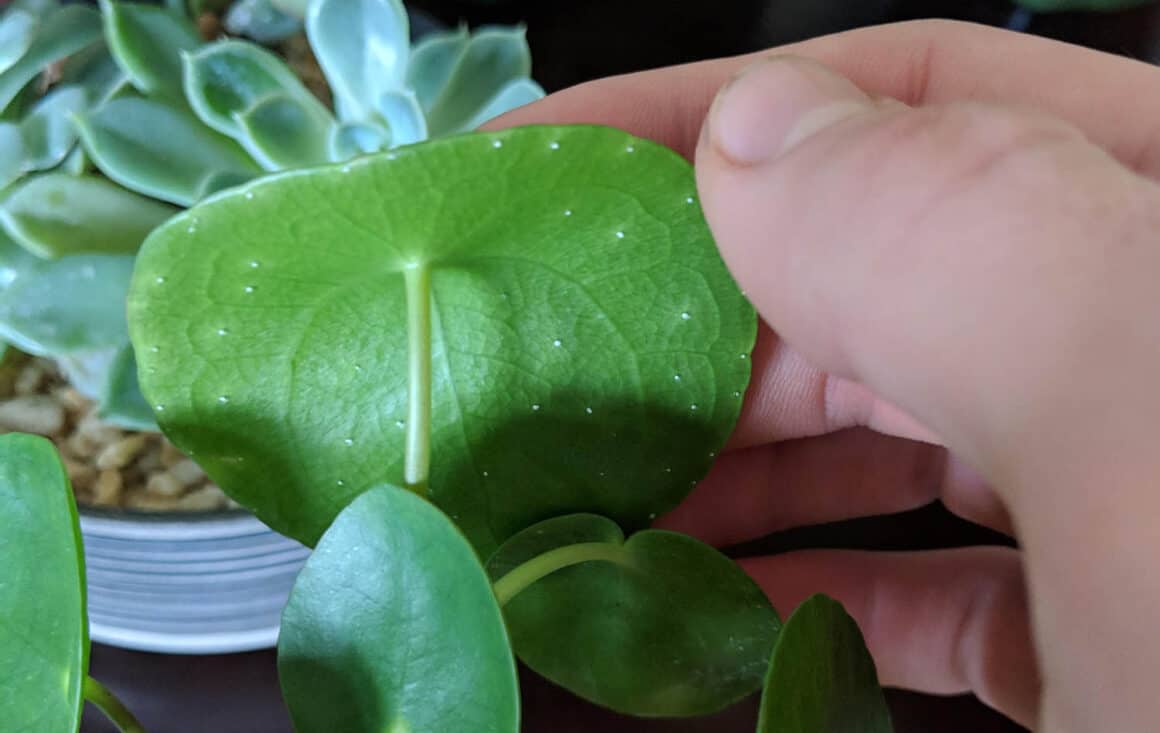
Pileas have tiny glands on the bottom of their leaves that they use to excrete water vapor that is a byproduct of their photosynthesis process. When Pileas are watered with tap water, the minerals that get absorbed into the Pilea from the tap water get excreted along with the water vapor in the form of those tiny white dots.
These dots should be wiped off the underside of the leaves to keep the pores clear. If you change from tap water to distilled water or you start leaving your water out overnight before using it, those white dots will stop appearing on your Pilea.
Bottom Watering vs. Top Watering for Pileas
There are two schools of thought when it comes to how you should water your Pilea: bottom watering and top watering.
To water your plant from the top, you simply pour water into the soil from the top. You should be careful when watering from the top to not use a heavy stream that would damage the stems of your foliage. I always like to pour water onto the soil beneath the leaves, instead of on the leaves themselves.
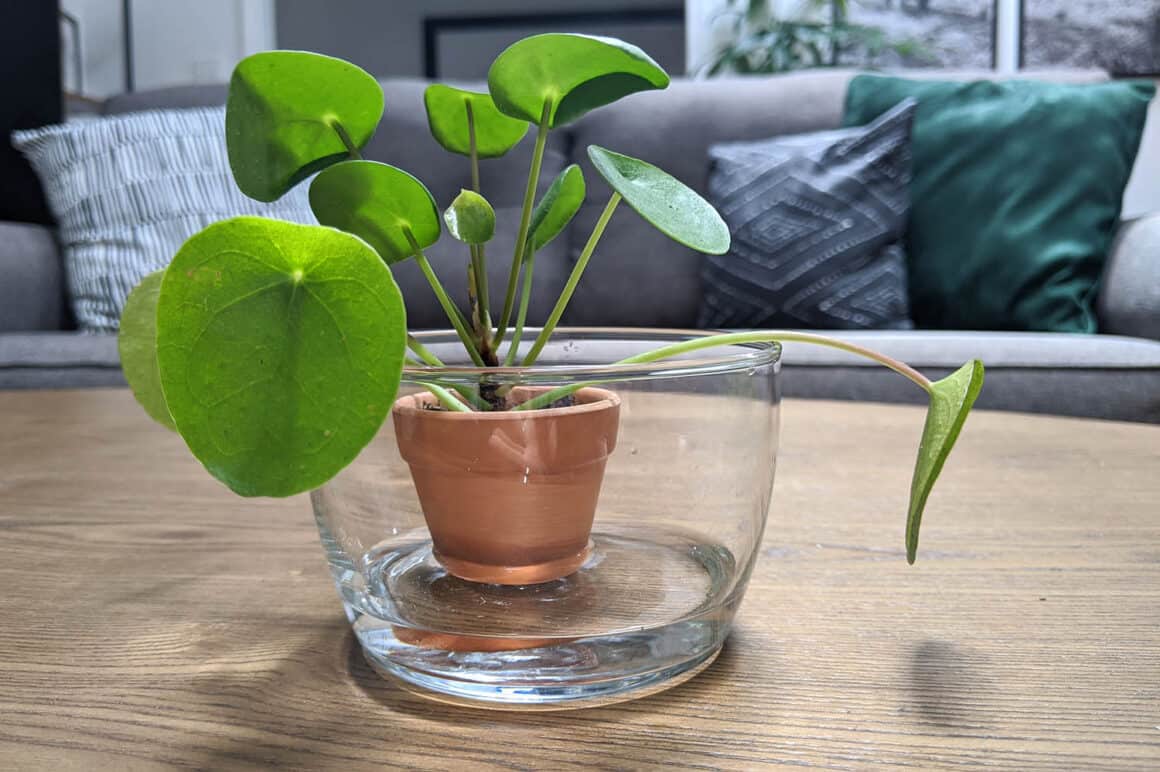
To water your plant from the bottom, set it in a saucer or shallow dish with water and allow it to be absorbed through the drainage hole in the bottom of your planter. This process can take a lot longer for larger pots than top watering, but will protect the foliage of your plant from breaking.
When top watering, you want to water until about 20% of the water you put in runs out the bottom drainage hole. For bottom watering, you’ll want to leave it in water for long enough that the top layer of soil becomes damp.
I have done both top and bottom watering with my Pileas. When my plants are very small from a new propagation, I usually choose bottom water as I believe the stems and leaves are more delicate and likely to be damaged by a stream of water from the top. Once plants reach a bigger size, I almost always water them from the top.
Final Thoughts
Pileas make a beautiful addition to any home, and, luckily, they are quite simple to care for. If you can learn to successfully water your Pilea, you will have mastered 95% of what it takes to have a healthy houseplant. Be sure that your Pileas are planted in quick-draining soil in a container that has a drainage hole and is not overly large for the plant. After that, all you have to do is water it when the top inch of soil is dry and you will be set!
P.S. How To Save An Overwatered Pilea
If you have a Pilea that has been the victim of overwatering and you want to try to save it, I wrote an article that includes a step by step process for determining the severity of the problem and what action to take. For more information on saving overwatered Pileas, click here to read the article.
